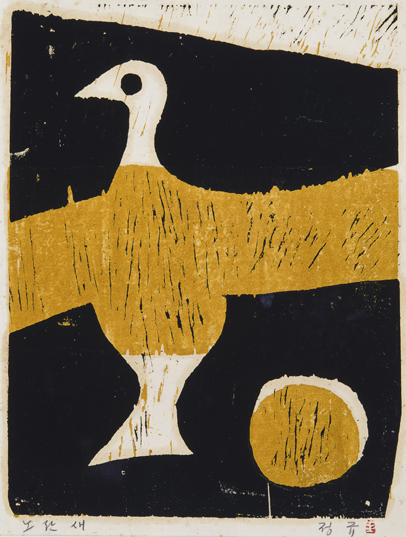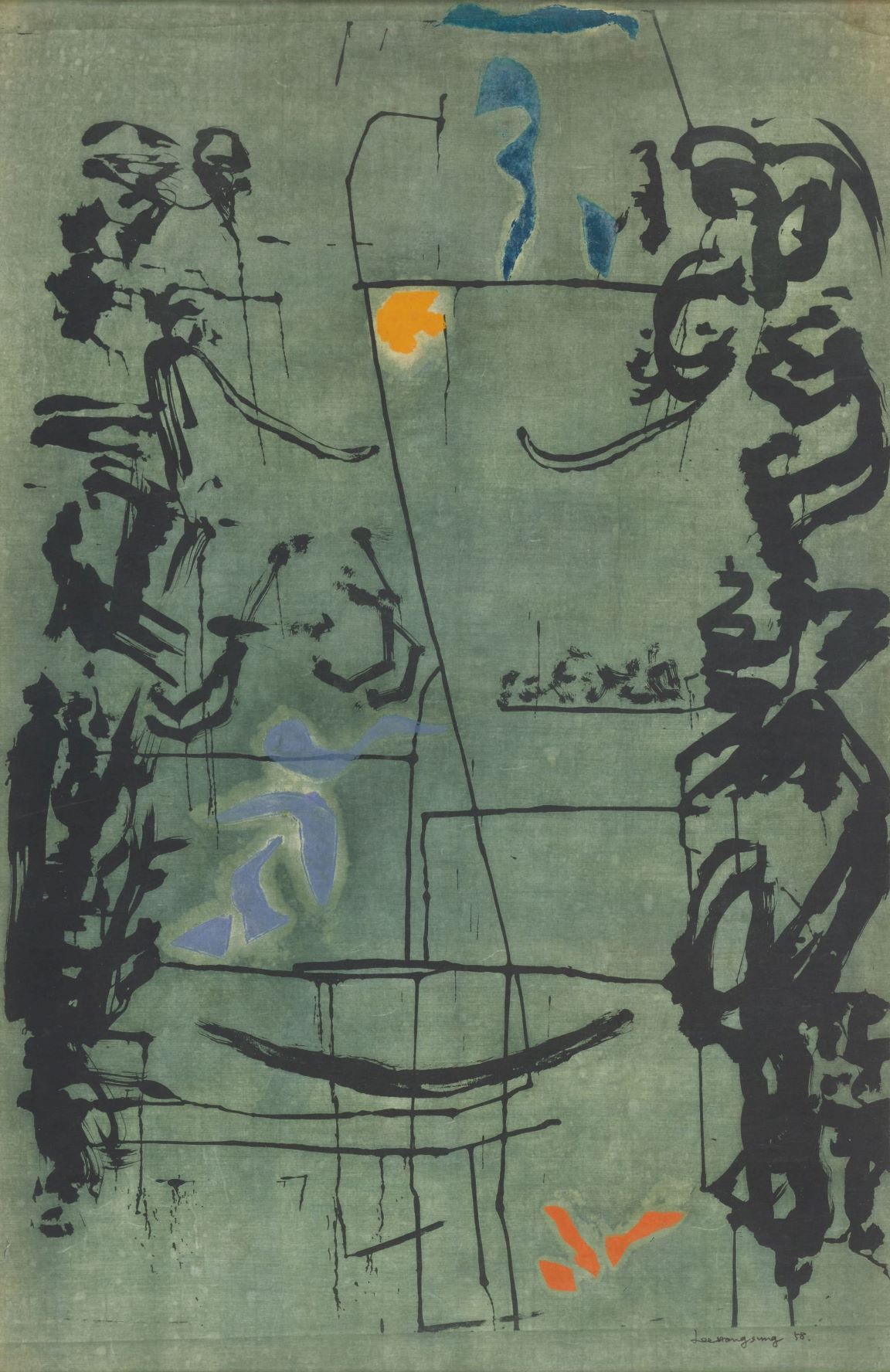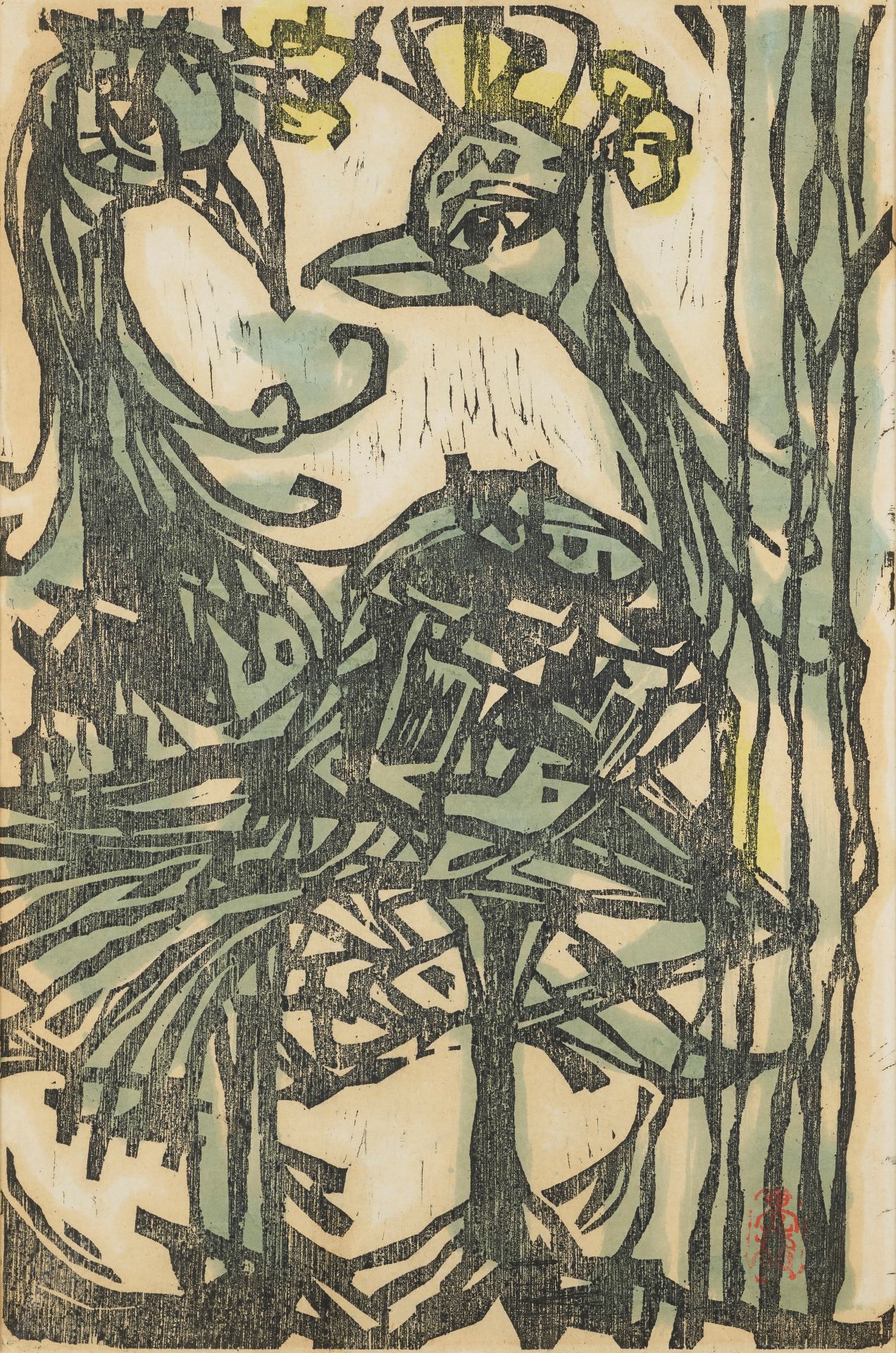
Chung Kyu Yellow Bird, early 1960s, Woodcut on paper, 41 x 32cm. MMCA collection
Chung Kyu
* Source: Multilingual Glossary of Korean Art. Korea Arts Management Service
Related
-

Korean Art Critics Association
Korean Art Critics Association is an organization founded by art critics in 1956. The founding members include; Choi Sunu, Lee Hangsung, Lee Kyungsung, Chung Kyu, Bang Geun-taek, Bae Gilgi, Chun Seung-bok, Kim Byungki, Kim Youngki, Kim Chung-up, and Kim Youngjoo. Lee Yil, a subsequent president of the group, established the quarterly art magazine Korean Journal of Art Criticism in 1986, and created the Korean Art Critics Association Award in 2009. Through this platform, the association continues to support artists and art writers.
-

Sinmisul
The first Korean art magazine published in 1956 by printmaker and Western-style artist Lee Hangsung. The first issue featured articles written by Do Sang-bong and Kim Byungki, as respective representatives of the Daehan Art Association (Daehan misul hyeopoe) and the Korean Artists Association (Hanguk misulga hyeopoe). The two organizations shared a rivalry that centered on the National Art Exhibition (Gukjeon). Other writers included Choi Soonwoo, Kim Chungup, Park Kosuk, Ahn Byeongyong, Kim Youngjoo, and Kim Sou. Most of the writers for the first issue were also the founding members of the Korean Art Critics Association, which was established in November. This suggests that Sinmisul was influential in the development of a national culture of critique. Until the 12th issue in July 1962, however, the magazine featured no direct critiques, and the magazine was discontinued after the 13th issue in 1963.
-

Korean Plastic Arts and Culture Research Institute
The Korean Plastic Arts and Culture Research Institute (Hanguk johyeong munhwa yeonguso) was an artistic and cultural institution that operated from 1955 to 1962 under the auspices of the U.S. Rockefeller Foundation. The institute was established as part of a support program of national museums, and its purpose was to explore product development and the advancement of Korean crafts and printmaking. As it carried out actual projects, its productivity was proved to have improved and its sales volume increased, raising the possibility of its self-reliance. The workforce was fostered around creative activities that combined modernity and practicality. The institute took a step closer to training younger generations and popularizing Korean crafts and printmaking by holding research presentations and lectures. Particularly in conjunction with the Korean Artwork Research Institute, which opened around the same time, it strove to inherit and modernize traditional ceramics. Among representative artists active at the institute are Chung Kyu, who studied ceramics at the Rochester Institute of Technology in the U.S.; Yoo Kangyul, who studied at the Tokyo School of Fine Arts and worked as a dye craftsman in the 1950s and as a printmaker in the 1960s; Yun Hyojoong, a sculptor from the Tokyo School of Fine Arts, and his recruits, including Yu Geunhyeong, Kim Wanbae, Choe Inhwan, and Ji Suntaek. The institute was shut down after three years of operation due to the Rockefeller Foundation’s withdrawal of financial support and other private reasons.
Find More
-

Lee Hangsung
Lee Hangsung (1919-1997) was a Western-style painter and printmaker who pioneered Korean contemporary printmaking and a leading publisher who promoted the publication and dissemination of art books. He learned painting from Kwon Jungrok, a Western-style painter active in Daejeon, and worked as a stage artist at Dongyang Theatre in Seoul. In 1945, he established a publishing company Munhwa Gyoyuksa and published art textbooks for elementary, middle, and high schools and art books such as Seoyang misulsa (History of Western art) and Segye misul jeonjip (Collection of world art). In 1956, he established another publishing company Sinmisulsa and published Sin Misul (New art), the first art magazine in Korea, thus exerting influence upon the formation of the culture of art criticism. Lee Hangsung led the founding of the Korea Prints Association [Hanguk panhwa hyeophoe] along with Yoo Kangyul, Chung Kyu, Choi Youngrim, and others. In 1958, Lee held the first solo exhibition of lithographs by a Korean artist. Winning an honorable mention for the lithograph Tender Heart of the Buddha at the fifth International Biennial of Contemporary Color Lithography held in 1959 at Cincinnati Art Museum in the U.S., he secured his place in the Korean art scene as a printmaker. Later, he produced print works using Joseon-era wooden blocks that were used for printing old books, letterheads, book covers, and those for imprinting patterns on rice cakes. In his later years, he continued to create works that revealed his Eastern spirituality by pictorializing Chinese characters, such as “念” (yeom, meaning idea), “情” (jeong, meaning affection), “思” (sa, meaning thought), and “心” (sim, meaning mind). Lee contributed to the development of art education by serving as president of the Korean Art Education Association [Daehan misul gyoyuk gyeophoe] and chairman of the Korean Committee of the International Society for Education [Gukje misul gyoyuk hyeophoe hanguk wiwonhoe].
-

Yoo Kangyul
Yoo Kangyul(1920-1976) was a Korean printmaker and dye craftsman who engaged in diverse activities from the late 1940s through the early 1960s. He entered the Azabu Middle School in Tokyo in 1933 and graduated from the Craft and Design Department at Nihon Art School in 1944. In 1941, while studying in Japan, Yoo’s work was selected for the Japanese Craftspeople Association Exhibition. He received apprenticeship education on dyeing at the Saito Craft Institute. After returning to Korea, Yoo worked as a principal lecturer and researcher at Lacquerware Inlaid with Mother-of-Pearl Training Center and Korean Plastic Arts and Culture Research Institute. In 1958, he received Rockefeller Foundation scholarship to study printmaking at New York University and the Pratt-Contemporaries Graphic Art Centre. He was later appointed as a professor at Hongik University and served until 1976. He was also active as an architectural advisor and interior designer. Among his notable works are the exhibition design for Anti-Communist Exhibition Hall of the Freedom Center (1966) and the Ceramic Mural for the National Assembly (1974). Yoo Kangyul founded the Korean Contemporary Printmaker Association [Hanguk hyeondae panhwaga hyeophoe] in 1968 to develop Korean printmaking. Moreover, he served as a judge of the Korean Art Grand Award Exhibition in 1969, a standing committee member for the construction of the National Museum of Korea in 1970, and a head judge for the National Tourist Folk Art Competition from 1971 to 1976. He won many awards including the Minister of Education Award (1953) and the Prime Minister Award (1954) at the National Art Exhibition (Gukjeon) and a presidential prize for the interior design of the National Museum of Korea (1970). Yoo did not hold a solo exhibition during his lifetime, but in 1978 Kyang Yul Yoo’s Exhibition was organized by his students and the National Museum of Modern Art, Korea (now MMCA). In 1981, Collection of Works by Yoo Kangyul was published. In 2000, his bereaved family donated Yoo’s collection to the MMCA and the National Museum of Korea.






